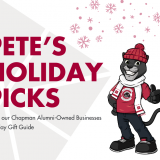
8 Proven Marketing Tactics for Selling More Products Alumni guest post by Ryan Robinson '12
May 11, 2017
In the U.S., more than 81% of shoppers report conducting online research before making big purchase decisions. On top of that, nearly 50% of people who do local searches visit a store within one day.
If you want to start a business, that makes staying on top of the latest digital marketing tactics crucial to attracting customers. From social media to blogging and search engine optimization, having a strong online presence for your growing business can do much more than just traditional word-of-mouth and offline marketing alone.
Regardless of what you sell, there are two basic principles you need to follow in order to increase your sales with online marketing tactics:
- Drive traffic to your website and convert visitors into email subscribers.
- Entice your email subscribers to visit your online or physical store.
First let’s talk about how to drive traffic to your website. Then we’ll focus on eight marketing tactics for getting those valuable subscribers into your online or physical store and buying products.
How to Drive Traffic to Your Website
Before you can hope to increase online sales, you need to have an active, healthy website with high quality content that motivates people to do business with you.
For most businesses, that means building trust with your community over time—something I’ve learned the hard way through several professional failures since graduating from Chapman.
One of the best ways to establish that rapport with your audience is by keeping your existing community up-to-date with blog content and educating new potential customers with regular educational content—at least twice a month. If you need some inspiration on what to write about from your company blog, here’s a creative list of 40+ different ideas for blog posts from Hubspot.
Before hitting publish on your content, do some keyword research to make sure that your content is optimized for eventually rising to the top of Google’s search results on a specific phrase related to your business.
When thinking about the types of search terms your customers are using online, start by asking yourself the question, “Who are my customers?” If you’re not completely sure of the trends and commonalities between your existing customers, do a bit of demographic research by polling your most recent or engaged ten to twenty customers rather than making guesses.
If you’re starting a graphic design and print shop, you’ll probably want to target business executives in their 40’s or startup founders that constantly network and attend trade shows. If you run a travel agency that caters to backpackers, you’ll probably want to target young professionals and digital nomads who can afford to travel and want the authentic local experience wherever they visit.
Depending on the kind of people you’re interacting with, you want to find them on the right social media channels. If you do B2B marketing consulting, you may want to run a sponsored post on LinkedIn or an ad campaign through Twitter. If you’re targeting direct consumers rather than commercial clients, focus on growing your audience on Facebook, Instagram or Pinterest to get the best reach for your demographic. Check out this definitive guide from Hootsuite to figure out which social network is right for your business.
How to Generate Email Subscribers
Once you’ve optimized the content you’re publishing on your blog, the next step is converting your readers into email subscribers for your business.
Be sure to include a prominent call-to-action for readers to subscribe across your website, in the sidebar of your blog and strategically placed within your blog posts, to maximize your opportunity for capturing customer emails.
If you’re starting a product-driven business, incentivize your readers with an immediate online or in-store discount in exchange for signing up for your email list and employ inexpensive or free tools like Sumo’s List Builder and Optinmonster to create visually appealing email optin forms, display exit-intent popups and more to increase your conversion rates.
For service-based business owners, consider offering a free download, do-it-yourself template, authoritative eBook, online course or complementary phone consultation in exchange for readers to sign up for your email list. If you can provide massive upfront value to your readers in a way that other businesses aren’t willing to do for free, you’ll put yourself in a position to build meaningful relationships with your readers—and convert them into customers.
8 Marketing Tactics for Converting Email Subscribers into Customers
Once you have a growing email list of people who interact with your brand, it’s time to begin experimenting with bringing them into your store and incentivizing them to buy. Here are eight creative tactics to get you started.
- Theme Days and Events
Get people to over to your store by hosting events that include the things they love. Even if you make an exciting product that practically sells itself, like gourmet cupcakes for example, you still need to build context around what your business does, who you are and what you want to represent within your community. This is especially important for businesses that don’t have excitement or shock value built-in, like if you sell office furniture.
Plan an event that’ll bring your email subscribers through the front door. It doesn’t always have to be related to what you sell, either. Going back to your demographic research, if you’ve uncovered that the majority of your customers are pet owners, consider hosting a doggie day at your consignment boutique, a smart and growing trend in retail. Alternatively, you could plan an event that aligns more directly with what your business does for your customers. If you own a farm-to-table restaurant, hosting a monthly cooking class that teaches customers about where the produce and meats they consume actually comes from could be an additional revenue stream that serves to get your most loyal customers even more engaged in your brand.
- Flash Sales
It’s not enough to send your subscribers a monthly coupon for 20% off their next purchase and expect them to show up at your store in droves. You have to create a sense of urgency. Send your subscribers a coupon for their next in-store purchase and tell them they have only 72 hours to redeem it.
Research shows time and time again that urgency works wonders in marketing. Tapping into the human fear-of-missing-out (FOMO) response is a surefire way to push people over the tipping point when they’re already interested in what you have to offer.
- Partnership with Local Philanthropy
Helping out whether through donation of funds or committing time to a good cause in your local community is a win-win, especially if it’s well-aligned with your business. Why not get involved in issues that matter to you and your customers? If you’re not sure which causes your customers care about most, send out a quick survey using Google Docs and ask them to vote on a few options you’re considering.
Once you’ve gotten that feedback, send a follow-up email with plans for your first fundraising event or details about what percentage of sales from each purchase will go to the philanthropy of choice next month. Whether it benefits the local no-kill animal shelter or raises money to support Habitat for Humanity, this gives your customers a sense of ownership and involvement in your business, which can foster a lasting relationship based on more than just transactions. Not only do you extend your brand’s local image and get the local community talking about you in a positive light, you’ll do some genuine good in the world at the same time.
- Click and Collect
In some cases it might actually be easier for customers to order online and come by your store to pick up their purchase from you. For example, if you run a furniture shop that sells handmade wooden tables, local customers can save on shipping by picking up the product from you instead—which also reduces the amount of work your team has to do.
Retailers like Kohl’s have successfully deployed this click and collect strategy to revive many of their struggling brick-and-mortar locations—there’s no reason your store can’t do the same. You can also glean a lot of valuable data on your customers by employing this practice. Kohl’s found that 75% of their click and collect shoppers were enrolled in their loyalty program, which suggests you too might be able to create more recurring business with the people who are really into your products.
- Retargeting Campaigns
Ad retargeting is a smart and proven method for bringing in more sales from people who’ve recently visited your website by surfacing ads to them across the web. By using a retargeting vendor like Adroll or Retargeter, you can install a tracking pixel on your website that’ll set a cookie in your visitor’s browser, which allows you to display advertisements to those visitors on other participating websites they visit for days, weeks even months after they’re on your site.
With your email subscribers, you’re speaking to people who already trust you enough to give you their email address. They’re more likely to buy from you than someone else if you stay top of mind when they’re ready to make a purchase.
- Facebook Ads
The genius of using Facebook ads to get the attention of your customers is that you can be laser-focused in who you target with your ad campaigns. Maybe your iPhone accessory shop has too much inventory with Disney character prints and you want to quickly unload hundreds of those types of cases. Create an ad campaign spending $50/day targeting followers who like Disney films on Facebook and surface your case designs to them at a discount and you’ll get results. This guide from AdEspresso will get you started on the right foot.
- Joint Partnerships
Go back to the demographic research on your customers and consider some of the other products, services and experiences they probably love. If you’re not sure, ask them! Are your customers into gourmet chocolate? Chances are, they probably love good coffee, too. Reach out to other businesses in your area that sell something your customers probably like and forge a joint partnership to co-promote your brands together. Host a chocolate and coffee tasting event after hours at your cafe and promote it to both of your email lists, distribute flyers and run a Facebook Ad campaign targeting local customers to get them out for your event.
- Giveaways
Everyone likes free stuff. If there’s a product of yours, something else you know your customers love, or even if there’s a low-margin item you plan on discontinuing in the future, a giveaway can be a smart way to create a lot of hype around your business in a relatively short period of time. Incentivize your email subscribers to come in and make in-store purchases by offering a free product or upgrade on all items bought in-store on a specific weekend. Just make sure your customers don’t get used to the expectation of free product, otherwise they may continue waiting for the next deal to roll around.
- Ryan Robinson during the “Walk Down Wall Street” class trip.
- Greek Life presidents
- Ryan Robinson and Austin Huffman
- Ryan Robinson ’12 and Matt Feldman ’12 at the Class of 2012 Commencement.
- Ryan Robinson, Maxime Gheysens and Matt Feldman at 2012 Commencement.





